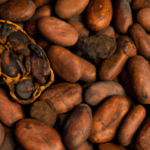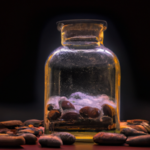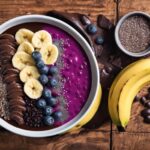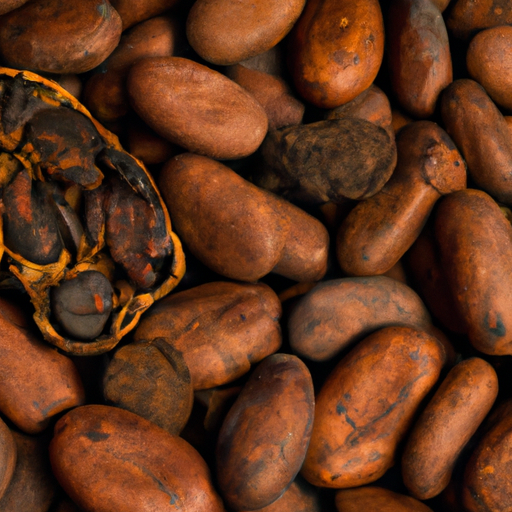Breaking down the process of preparing raw cacao from a block involves several steps. This subsection will guide you through each of these steps in detail.
Firstly, it’s important to understand the benefits of raw cacao and why it’s worth the effort to prepare it yourself. Raw cacao is packed with antioxidants, minerals, and nutrients that can provide numerous health benefits. By preparing it from a block, you have more control over the quality and purity of the cacao, ensuring that you are getting the maximum nutritional value.
Next, we will show you how to choose the perfect cacao block. Look for a high-quality, organic cacao block that is free from additives or preservatives. This will ensure that you are starting with the best possible ingredient.
Once you have your cacao block, it’s time to break it down into smaller, more manageable pieces. You can use a sharp knife or a grater to achieve this. Breaking it down will make it easier to melt and incorporate into your recipes.
Now that you have your smaller cacao pieces, it’s time to melt them. There are several methods you can use for this, such as using a double boiler or a microwave. Choose the method that works best for you and follow the instructions carefully to avoid burning or overheating the cacao.
To add flavor to your prepared raw cacao, you can experiment with different ingredients. You can add a pinch of sea salt for a savory twist, a dash of vanilla extract for a hint of sweetness, or even spices like cinnamon or chili powder for a unique flavor profile. The key is to start with small amounts and gradually adjust to your taste preferences.
Finding the perfect balance of sweetness is also crucial. You can use natural sweeteners like honey, maple syrup, or coconut sugar to enhance the flavor of your cacao. Again, start with small amounts and taste as you go until you achieve the desired level of sweetness.
Once you have mastered the basics of preparing raw cacao from a block, it’s time to get creative. You can use your prepared cacao to make a variety of delicious treats like homemade chocolate bars, truffles, or hot chocolate. The possibilities are endless, so don’t be afraid to experiment and have fun with it.
Finally, we will share some tips on storing and preserving your prepared cacao to ensure its freshness. It’s best to store it in an airtight container in a cool, dry place away from direct sunlight. This will help maintain its quality and prevent it from absorbing any unwanted odors or flavors.
Now that you have a clear understanding of how to prepare raw cacao from a block, it’s time to elevate your chocolate game to a whole new level. Get ready to indulge in the decadent, velvety chocolate experience you’ve been dreaming of. Let’s dive in!
Key Takeaways
- Raw cacao from a block is packed with antioxidants, minerals, and nutrients, offering numerous health benefits such as improving heart health, boosting mood, and increasing energy levels.
- Preparing raw cacao from a block allows for control over the quality and purity of the final product, ensuring it is free from additives and preservatives.
- The distinct taste of raw cacao compared to processed chocolate makes it a unique and flavorful ingredient to work with.
- When preparing raw cacao, one can experiment with flavoring options such as sea salt, vanilla extract, or spices, and also try different flavor combinations to enhance the taste.
Understanding Raw Cacao: Learn about the benefits and differences of raw cacao compared to processed chocolate.
If you’re looking for a healthier alternative to processed chocolate, raw cacao is a game-changer with its numerous benefits and distinct taste. Understanding the health benefits and differences of raw cacao compared to processed chocolate is crucial when preparing it from a block.
Raw cacao is packed with antioxidants, vitamins, and minerals, which are often lost during the processing techniques used to make traditional chocolate. By consuming raw cacao, you can enjoy improved heart health, boosted mood, and increased energy levels.
Additionally, raw cacao has a rich and intense flavor that is quite different from the sweetness of processed chocolate. So, when choosing the right cacao block, it’s important to consider the quality and origin to ensure the best flavor and results.
Choosing the Right Cacao Block: Discover how to select a high-quality cacao block for the best flavor and results.
When choosing the right cacao block, it’s important to prioritize exceptional flavor and optimal results. To achieve this, explore cacao origins and select varieties that match your taste preferences. Different regions produce cacao with unique flavor profiles, ranging from fruity and floral to earthy and robust. For a versatile and flavorful experience, opt for blocks made from a blend of cacao beans from various origins.
In addition, pay attention to the quality and freshness of the cacao block. Check for signs of moisture or discoloration, as these may indicate poor storage conditions. By selecting a high-quality cacao block, you set the stage for a delicious and satisfying end product.
Now, let’s move on to the next section and learn the art of breaking down the block into smaller pieces for easier preparation.
Breaking Down the Block: Master the art of breaking down a cacao block into smaller pieces for easier preparation.
To effortlessly conquer the task at hand, become adept at splitting the solid mass of cacao into bite-sized fragments, simplifying the process for seamless execution. Here are some breaking techniques and portion control tips to help you prepare raw cacao from a block:
- Use a sharp knife to carefully slice off small pieces from the block.
- Apply gentle pressure with a mallet or hammer to break the block into smaller chunks.
- Utilize a grater or food processor to create finer, powdered cacao.
- Freeze the block for a few minutes before breaking it to prevent it from melting too quickly.
Mastering these techniques will ensure that your cacao is perfectly portioned and ready for the next step.
In the subsequent section, we will explore different methods and techniques for melting raw cacao, such as using a double boiler or microwave, to further enhance your cacao preparation skills.
Melting the Cacao: Explore different methods and techniques for melting raw cacao, such as using a double boiler or microwave.
Once you’ve mastered the art of breaking down the cacao block, it’s time to explore different methods and techniques for melting the raw cacao. There are two main methods: using a double boiler or a microwave.
A double boiler is a traditional method that provides gentle and even heat distribution. It involves placing a heat-resistant bowl with the cacao over a pot of simmering water. This method requires more time and attention, but it helps prevent the cacao from overheating or burning.
On the other hand, the microwave method is quicker and more convenient. Simply chop the cacao into small pieces and place them in a microwave-safe bowl. Heat in short intervals, stirring in between, until the cacao is fully melted.
Once the cacao is melted, you can pour it into different types of chocolate molds to create various shapes and sizes. These molds can be found in different materials, such as silicone or polycarbonate, and come in a variety of designs.
To enhance the taste of your raw cacao, you can experiment with various ingredients and flavors, such as vanilla or sea salt. Adding these elements can elevate the flavor profile and create a unique and personalized experience. Transitioning into the next section, don’t be afraid to get creative and try out different combinations to find your perfect flavor blend.
Adding Flavor: Experiment with various ingredients and flavors to enhance the taste of your raw cacao, such as vanilla or sea salt.
Get ready to take your raw cacao to the next level by adding a burst of flavor with ingredients like vanilla or a sprinkle of sea salt. When it comes to enhancing the taste of raw cacao, experimenting with different spices and trying unique flavor combinations is key.
You can start by adding a touch of vanilla extract to your melted cacao, which adds a subtle sweetness and depth of flavor. Alternatively, a pinch of sea salt can help to balance out the bitterness of the cacao, creating a harmonious taste experience.
The possibilities are endless when it comes to flavoring your raw cacao, so feel free to get creative and try out different combinations to find your perfect match.
Now, let’s move on to exploring sweetening options, where we’ll discover natural sweeteners that can be used to balance the bitterness of raw cacao, like honey or maple syrup.
Sweetening Options: Discover natural sweeteners that can be used to balance the bitterness of raw cacao, like honey or maple syrup.
Discover a world of natural sweetness as you explore the use of honey or maple syrup to balance the bitter notes of your raw cacao. Here are three alternative sweeteners that can enhance the flavor of your cacao:
-
Agave nectar: This sweetener is derived from the agave plant and has a mild, honey-like taste. It dissolves easily in liquids and works well in recipes that require a smooth texture.
-
Coconut sugar: Made from the sap of coconut palm trees, coconut sugar adds a rich caramel flavor to your cacao. It has a lower glycemic index than regular sugar, making it a healthier option.
-
Date syrup: Made from dates, this syrup has a deep, sweet flavor that pairs well with the bitterness of raw cacao. It can be used as a natural sweetener in various recipes.
Now that you know about these honey alternatives and alternative sweeteners, you can enjoy a perfectly balanced raw cacao experience. Get creative and learn how to use your prepared raw cacao to make a variety of delicious treats, such as chocolate bars or hot cocoa.
Creating Different Treats: Get creative and learn how to use your prepared raw cacao to make a variety of delicious treats, such as chocolate bars or hot cocoa.
Unleash your creativity and indulge in the decadent world of homemade chocolate bars and rich, velvety hot cocoa using your prepared raw cacao. With a block of raw cacao, the possibilities are endless. You can transform it into luscious chocolate truffles, perfect for gifting or treating yourself to a luxurious treat. Or, if you’re looking for a refreshing and nutritious option, blend your prepared raw cacao into creamy cacao smoothies that will satisfy your chocolate cravings while nourishing your body.
To help you get started, here’s a table showcasing some ideas for using your prepared raw cacao:
| Treat | Description |
|---|---|
| Chocolate Bars | Create your own personalized chocolate bars |
| Hot Cocoa | Indulge in a rich, velvety cup of hot cocoa |
| Chocolate Truffles | Make delectable truffles with various fillings |
| Cacao Smoothies | Enjoy a refreshing and nutritious chocolate drink |
Now that you’ve explored the world of treats, let’s move on to the next step: storing and preserving. Understand the best practices for storing and preserving your raw cacao to maintain its freshness and flavor.
Storing and Preserving: Understand the best practices for storing and preserving your raw cacao to maintain its freshness and flavor.
After learning how to create a variety of treats with your prepared raw cacao, it’s essential to understand the best practices for storing and preserving this precious ingredient. Proper storage techniques will ensure that your raw cacao retains its freshness and flavor over time.
To begin, store your raw cacao in an airtight container in a cool, dark place, away from direct sunlight and moisture. This will prevent oxidation and maintain its rich aroma and taste. Additionally, consider using vacuum-sealed bags or jars to further protect it from air exposure.
If you live in a humid climate, you can also add a desiccant packet to absorb any excess moisture. By following these preserving methods, you can prolong the shelf life of your raw cacao and continue to enjoy its incredible flavor.
Finally, sit back, relax, and savor the rich and pure taste of your homemade raw cacao creations.
Enjoying the Fruits of Your Labor: Finally, sit back, relax, and savor the rich and pure taste of your homemade raw cacao creations
Kick back, unwind, and indulge in the luscious and heavenly flavors of your homemade raw cacao masterpieces. After all the effort you’ve put into preparing and preserving your raw cacao, it’s time to enjoy the fruits of your labor. To enhance the flavor of your raw cacao creations, consider flavor pairing options. For a hint of freshness, try combining your cacao with a sprinkle of sea salt or a dash of cinnamon. If you prefer a more indulgent taste, pair it with a dollop of whipped cream or a drizzle of caramel sauce. Additionally, serving suggestions can elevate the experience. Serve your creations in elegant small cups or use them as a topping for desserts like ice cream or pancakes. Get creative and experiment with different flavor combinations and serving styles to fully savor the rich and pure taste of your homemade raw cacao.
| Flavor Pairing | Serving Suggestions |
|---|---|
| Sea salt | Elegant small cups |
| Cinnamon | Topping for ice cream |
| Whipped cream | Drizzle of caramel sauce |
| Vanilla extract | Garnish for pancakes |
| Hazelnut spread | Sprinkle on fruit salad |
Frequently Asked Questions
Can I use processed chocolate instead of raw cacao?
No, processed chocolate cannot be used as a substitute for raw cacao in recipes. Raw cacao has numerous health benefits, such as higher antioxidant content and lower sugar content compared to processed chocolate.
How long does it take to break down a cacao block into smaller pieces?
Breaking down a cacao block into smaller pieces can take about 5-10 minutes, depending on the tools used. A sharp knife or a food processor can make the process quicker and more efficient.
Can I melt raw cacao in a regular saucepan?
No, raw cacao cannot be melted without a saucepan. However, there are alternative methods for melting cacao such as using a double boiler or a microwave. These methods ensure even and controlled melting of the cacao.
What are some unique flavor combinations to try with raw cacao?
Some unique flavor combinations to try with raw cacao include spicy cacao combinations like cayenne pepper or chili powder, and sweet and fruity cacao pairings like orange zest or dried raspberries.
How long can I store my prepared raw cacao before it goes bad?
The shelf life of prepared raw cacao depends on storage methods. To ensure freshness, store it in an airtight container in a cool, dark place. Properly stored, prepared raw cacao can last up to six months.
Can Raw Cacao and Chia Seeds be Used Together in Recipes?
Yes, raw cacao and chia seeds can be used together in recipes. They can be combined in smoothies, energy balls, overnight oats, and even in baked goods like muffins and cookies. These ingredients add nutritional value and a delicious flavor to raw cacao and chia seeds recipes.
Conclusion
After following the meticulous steps of breaking down and melting the raw cacao block, it is time to experiment with flavors and sweeteners.
First, gather your desired ingredients such as nuts, dried fruits, or spices. These will add depth and complexity to your raw cacao creations.
Next, mix in your chosen flavors and sweeteners. This could include ingredients like vanilla extract, sea salt, or coconut sugar. Be sure to taste and adjust as needed to achieve the perfect balance of flavors.
Once you have added your desired ingredients, pour the mixture into molds or spread it onto a baking sheet lined with parchment paper.
Allow the raw cacao mixture to cool and solidify in the refrigerator for at least an hour. This will ensure that your treats have the perfect texture and consistency.
Finally, remove your homemade raw cacao creations from the molds or baking sheet. Admire their beautiful appearance and indulge in their rich and pure taste.
Sit back, surrender to the sublime sensations, and savor the sumptuous satisfaction of your raw cacao triumphs.

















